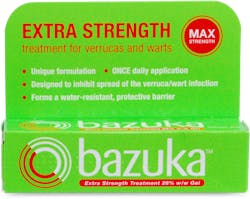Salatac Wart Gel 8g
Salatac Wart Gel 8g
What 500,000+ customers say about medino:
Description
Salatac Wart Gel 8g is a specialized solution for addressing skin conditions such as warts, verrucas, corns, and calluses. Its formula includes salicylic acid and lactic acid, which work together to soften the skin, facilitating the removal of these skin formations. Additionally, the gel's composition of camphor, pyroxylin, ethanol, and ethyl acts against the virus responsible for these skin issues and helps reduce swelling. Salatac Gel is designed for ease of use and is suitable for a broad range of users, including adults, children, and the elderly, ensuring a comfortable and effective treatment for these common skin concerns.
Key Features
- Salicylic acid (12.0% w/w) and lactic acid (4.0% w/w) in the gel help soften skin for easier removal of warts, verrucas, corns, and calluses.
- Ingredients like camphor, pyroxylin, ethanol, and ethyl work against the virus causing these skin problems and help in reducing swelling.
- Comes with a special applicator for targeted application.
- Includes an emery board for effortless removal of softened skin.
- Appropriate for use by a diverse group including adults, children, and the elderly.
- Aims for a comfortable and efficient solution to prevalent skin issues.
What symptoms or conditions can be treated with Salatac Wart Gel 8g?
Salatac Wart Gel 8g is effective for the treatment of warts, verrucas, corns, and calluses.
What are the benefits of using Salatac Wart Gel 8g?
The gel helps in softening the affected skin for easier removal and combats the virus responsible for these skin problems. It also reduces swelling, providing a comfortable and effective solution.
How does Salatac Wart Gel 8g work?
Salatac Wart Gel 8g contains salicylic acid and lactic acid to soften the skin, aiding in the removal of the affected areas. It also has components that fight the virus and reduce swelling.
Are there any known side effects?
Some users may experience mild, transient irritation. If severe or persistent pain/irritation occurs, it is advisable to halt or discontinue use.
How long does it take for Salatac Wart Gel 8g to work?
The duration of treatment varies based on the size and resistance of the wart, verruca, corn, or callus.
Can Salatac Wart Gel 8g be used by diabetics?
Diabetics or individuals with poor blood circulation in their hands or feet are advised not to use Salatac Wart Gel 8g.
Ingredients
- Salicylic Acid 12.0% w/w
- Lactic Acid 4.0% w/w
Usage and Instructions
Adults, children and the elderly:
Salatac Gel should be applied once daily. The gel should be applied once every night. Treatment can take up to twelve (12) weeks for resistant lesions to disappear, and it is necessary to persevere with treatment.
- Every night, soak the affected site in warm water for 2 to 3 minutes.
- Dry thoroughly with the patient's own towel.
- Carefully apply one or two drops of the gel to the lesion and allow to dry over its surface. Take care to avoid spreading on to surrounding normal skin. No adhesive plaster is necessary.
- The following evening, carefully remove and discard the elastic film formed from the previous application, and reapply the gel. Occasionally, if removal of the elastic film proves difficult, carefully reapply the gel over it and allow to dry. This should help thicken the film to assist removal. If necessary, such re-application may be made on two or three successive days.
- Once a week, gently rub away the treated surface using an emery board, as provided, or pumice stone used only for this purpose, before re-applying the gel.
- The wart, verruca, corn or callus may take up to twelve (12) weeks to disappear and it is important to persevere with the treatment.
- At the end of treatment, if the elastic film is difficult to remove, it may be allowed to remain on the skin until it sheds.
Warnings
Not to be used on or near the face, intertriginous or anogenital regions or by diabetics or individuals with impaired peripheral blood circulation.
Not to be used on moles, birthmarks, hairy warts or on any other skin lesions for which Salactol is not indicated.
Not to be used in cases of sensitivity to any of the ingredients.
Keep away from the eyes and mucous membranes.
The gel should be applied carefully to the wart, verruca, corn or callus only, to avoid possible irritation of surrounding normal skin.
Some mild, transient irritation may be expected, but in cases of more severe or persistent pain/irritation, the treatment should be suspended and/or discontinued.
Side Effects
Salatac may be irritant in certain patients, which in rare instances may appear as a temporary blemish on the skin.






